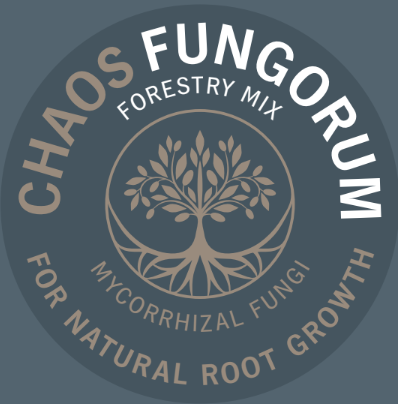
Species list
edible forest garden mix
20 species ectomycorrhizae
Amanita fulva, Tawny Grisette – A beautiful mushroom and a good edible (must be cooked): commonly occurs with beech, oak, sweet chestnut, birch and pine.
Amanita rubescens, The Blusher – A very common mushroom, and an excellent edible (though it must be cooked), happy with a wide range of deciduous and coniferous trees.
Amanita vaginata, Grisette – as for Tawny Grisette, above.
Boletus badius, Bay Bolete – An excellent relative of the penny bun, usually free of maggots.
Boletus edulis, Penny bun, – Also known as the Cep or Porcini, this is perhaps the best eating of all the wild fungi. Occurs with a very wide range of trees both deciduous and coniferous.
Cantharellus cibarius, Chanterelle – Needs no introduction, one of the very best edible mushrooms and found principally with oak, beech and pine.
Cantharellus tubaeformis, Winter or Trumpet Chanterelle – A very good edible, excellent for drying, fruits in the autumn and early winter, surviving early frosts. At least partially saprotrophic – helps decompose dead wood and stumps. Happy with many trees both deciduous and coniferous.
Cortinarius caperatus, The Gypsy – A large and delicious edible mushroom, common in the Scottish highlands and Scandinavia, associating with many trees.
Craterellus cornucopiodes, Horn of Plenty
Hydnum repandum, Hedgehog Mushroom – one of the best edible mushrooms, grows with a wide range of deciduous and coniferous trees. Hydnum rufescens, Hedgehog Mushroom – as above, but with a distinctive reddish colour to the cap. Excellent eating.
Lactarius deterrimus, False Saffron Milk-cap – grows with spruce, pine, and bearberry (Arctostaphylos uva-ursi), a decent edible like the better known Saffron Milk-cap.
Lactarius quietus, Oak Milk-cap
Laccaria amethystina, Amethyst Deceiver – A very common and gregarious mushroom, happy with almost any tree, and decent to eat.
Laccaria laccata, The Deceiver – As above, but purely flesh/buff coloured.
Leccinum scabrum, Brown Birch Bolete – A common mycorrhizal mushroom associated with birches. Good dried.
Leccinum versipelle, Orange Birch Bolete – Another excellent edible mushroom which associates with birches.
Russula atropurpurea, Blackish Purple Russula – a common species associating especially with oak and pine.
Russula ochroleuca, Common Yellow Russula – happy with a wide range of trees, a good firm-fleshed mushroom.
Suillus bovinus, Bovine bolete – a much studied mycorrhiza found in association with pines. Best dried.
Tuber aestivum, Summer Truffle
(Also includes a mixture of native endomycorrhizal species, including Rhizophagus intraradices and Glomus mossae. These will benefit some tree and most non-tree species apart from brassicas and ericaceous plants, but do not form edible mushrooms.)
forest garden mix
44 species ectomycorrhizaeAmanita fulva
Amanita fulva
Amanita muscaria
Amanita rubescens
Amanita vaginata
Boletus edulis
Cantharellus cibarius
Cantharellus tubaeformis
Cortinarius alboviolaceous
Cortinarius armillatus
Cortinarius collinitus
Cortinarius incisus
Craterellus cornucopiodes
Hebeloma crustuliformis
Hydnum repandum
Hydnum rufescens
Laccaria amethystina
Laccaria laccata
Laccaria proxima
Lactarius aurantiacus
Lactarius deterrimus
Lactarius obscuratus
Lactarius pubescens
Lactarius quietus
Lactarius tabidus
Lactarius torminosus
Lactarius uvidus
Lactarius vietus
Leccinum holopus
Leccinum scabrum
Leccinum versipelle
Naucoria escharoides
Naucoria striata
Paxillus involutus
Russula cyanoxantha
Russula delica
Russula emetica
Russula foetens
Russula fragilis
Russula heterophylla
Russula nigricans
Russula ochroleuca
Russula torulosa
Suillus bovinus
Tuber aestivum
(Also includes a mixture of native endomycorrhizal species, including Rhizophagus intraradices and Glomus mossae. These will benefit some tree and most non-tree species apart from brassicas and ericaceous plants, but do not form edible mushrooms.)

